Related Research Articles

A Marine expeditionary unit is the smallest air-ground task force (MAGTF) in the United States Fleet Marine Force. Each MEU is an expeditionary rapid reaction force ready to any crisis, whether it be disaster aid or a combat mission. Marine amphibious unit (MAU) was the name used until the late 1980s.

The 1st Commando Regiment is an Australian Army Reserve special forces unit, part of Special Operations Command with an integrated structure of regular (full-time) soldiers and reserve (part-time) soldiers, which together with the full-time Australian Army 2nd Commando Regiment, provides the commando capability to Special Operations Command. Raised in 1955 it is the oldest unit within Special Operations Command and in 2008 deployed to Afghanistan to become the first Australian Army Reserve force element on combat operations since World War II. The regiment is the Command's capability lead for special warfare.
United States special operations forces (SOF) are the active and reserve component forces of the United States Army, Marine Corps, Navy and Air Force, as designated by the Secretary of Defense and specifically organized, trained, and equipped to conduct and support special operations. All active and reserve special operations forces are assigned to the United States Special Operations Command (USSOCOM).

The United States Army Special Operations Command (Airborne) (USASOC ( YOO-sə-sok)) is the command charged with overseeing the various special operations forces of the United States Army. Headquartered at Fort Liberty, North Carolina, it is the largest component of the United States Special Operations Command. It is an Army Service Component Command. Its mission is to organize, train, educate, man, equip, fund, administer, mobilize, deploy and sustain Army special operations forces to successfully conduct worldwide special operations.

Jungle warfare or woodland warfare is warfare in forests, jungles, or similar environments. The term encompasses military operations affected by the terrain, climate, vegetation, and wildlife of densely-wooded areas, as well as the strategies and tactics used by military forces in these situations and environments.

The Marine Commandos, abbreviated to MARCOS and officially called the Marine Commando Force (MCF), are the special forces of the Indian Navy. The MARCOS were originally named Indian Marine Special Force, which was later changed to Marine Commando Force to impart "an element of individuality" to it, according to the Indian Navy. The abbreviation 'MARCOS' was coined afterwards.

The Kopaska is the premier frogman and underwater demolition unit of the Indonesian Navy. The unit's motto is in Sanskrit: Tan Hana Wighna Tan Sirna. The unit's main duties are underwater demolition, destroying main underwater installations, reconnaissance, prisoner snatches, preparing beaches for larger naval amphibious operations, and counter-terrorism. During peacetime, the unit also deploys a team to serve as security personnel for VIPs and VVIPs. The personnel of Kopaska are recruited from Indonesian Navy seamen. Like other Indonesian special forces, Kopaska is trained to be able to conduct operations in the sea, including underwater, on land and airborne.
In the United States Marine Corps, a Marine Air–Ground Task Force is the principal organization for all missions across the range of military operations. MAGTFs are a balanced air–ground, combined arms task organization of Marine Corps forces under a single commander that is structured to accomplish a specific mission. The MAGTF was formalized by the publishing of Marine Corps Order 3120.3 in December 1963 "The Marine Corps in the National Defense, MCDP 1-0". It stated:

1st Battalion, 25th Marines (1/25) is a reserve infantry battalion in the United States Marine Corps located throughout New England and upstate New York and consisting of approximately 850 Marines and Sailors. The battalion falls under the 25th Marine Regiment in the 4th Marine Division.
148 (Meiktila) Commando Forward Observation Battery is a specialist Naval Gunfire Support Forward Observation (NGSFO) unit within 29 Commando Regiment Royal Artillery of 3 Commando Brigade Royal Marines.

The Special Actions Detachment or DAE is the tier one special force maritime unit of the Portuguese Navy. It is part of the Portuguese Marine Corps. Raised in 1985, the DAE is one of the smallest special forces units within the Portuguese Armed Forces. It is responsible for conducting air-sea rescue, amphibious reconnaissance, amphibious warfare, black operation, bomb disposal, CBRN defense, coastal raiding, counterterrorism, direct action, executive protection, hostage rescue, irregular warfare, ISTAR, long-range penetration, JTAC, manhunt high-value target, maritime sabotage, mountain rescue, naval boarding, operation behind high risk enemy lines, special operations, special reconnaissance, tracking targets, underwater demolition, unconventional warfare, other missions in support of Portuguese and NATO armed forces. DAE's mission and training are similar to American special forces and it often trains with them.
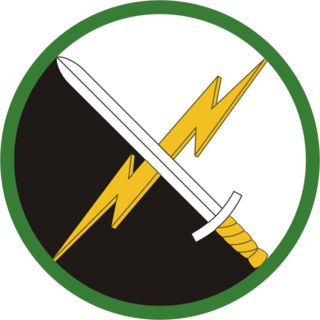
The 1st Information Operations Command (Land), formerly the Land Information Warfare Activity Information Dominance Center (LIWA/IDC), is an information operations unit under the operational control of U.S. Army Cyber Command (ARCYBER) and headquartered at Fort Belvoir, Virginia.
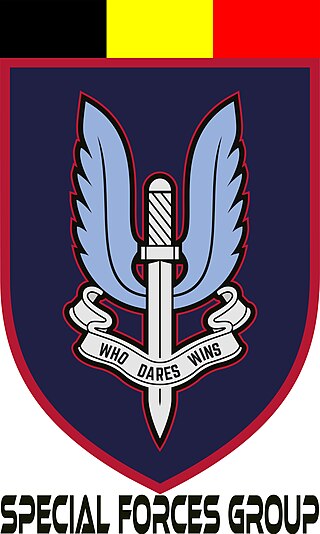
The Special Forces Group is the special forces unit in the Land Component of the Belgian Armed Forces.

The 158th Infantry Regiment ("Bushmasters") is an infantry unit of the Arizona National Guard. The regiment has served abroad in World War I, World War II and Afghanistan.
The Land Warfare Centre (LWC) is an Australian Army training establishment that is responsible for the provision of promotion courses to commissioned and non commissioned officers (NCOs) in an "all corps" setting. It was originally established during World War II at Canungra, Queensland, as the Jungle Training Centre to prepare troops for combat in the South West Pacific Area. During the 1950s and 1960s, the centre fulfilled a similar role, but since then has evolved to provide a broader spectrum of training courses with detachments at a number of bases across Australia.
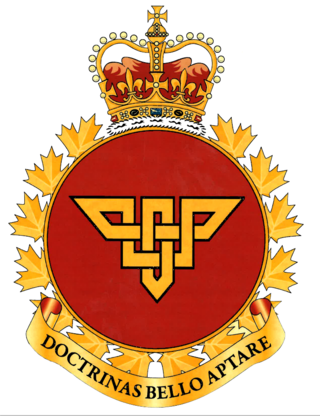
The Canadian Manoeuvre Training Centre (CMTC) is the Canadian Army's functional centre of excellence (FCoE) for collective training (CT) and is the army CT training authority on behalf of its higher headquarters, the Canadian Army Doctrine and Training Centre (CADTC). It is housed by 3rd Canadian Division Support Base Detachment Wainwright, in Denwood, Alberta.
Mission Command Training Program, based at Fort Leavenworth, Kansas, is the U.S. Army's only worldwide deployable Combat Training Center. MCTP provides full spectrum operations training support for senior commanders and their staffs so they can be successful in any mission in any operational environment. Its Senior Mentors counsel and offer their experience to Army senior commanders, subordinate commanders and staff. Additionally, MCTP's professional observer-trainers assist units with objective feedback and suggestions for improvement.
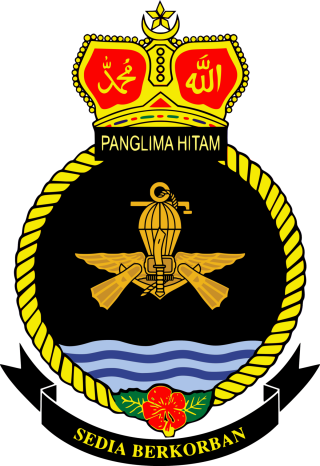
The Pasukan Khas Laut, commonly abbreviated to PASKAL, is the principal special operations force of the Royal Malaysian Navy.
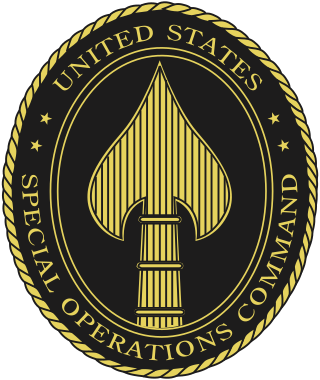
The United States Special Operations Command is the unified combatant command charged with overseeing the various special operations component commands of the Army, Marine Corps, Navy, and Air Force of the United States Armed Forces. The command is part of the Department of Defense and is the only unified combatant command created by an Act of Congress. USSOCOM is headquartered at MacDill Air Force Base in Tampa, Florida.
Combat Training Centre – Jungle Training Wing (CTC-JTW) is located in Tully, Queensland and are the Australian Army's specialists in jungle warfare, with their primary mission being to deliver basic and advanced jungle warfare training to dismounted Combat Team sized organisations. Most of the Combat Teams that complete a Sub-Unit Training (SUT) rotation at JTW are infantry rifle companies from within the Royal Australian Regiment.
References
- ↑ Australian Army (13 September 2016). "Combat Training Centre". www.army.gov.au. Retrieved 21 April 2020.
- ↑ Lewis, James (5 January 2018). "Return to the Jungle: A Renaissance of Close Country Warfare". Grounded Curiosity. Retrieved 21 April 2020.
- ↑ "Soldiers training for war in the jungle". Townsville Bulletin. 1 March 2018. Retrieved 21 April 2020.